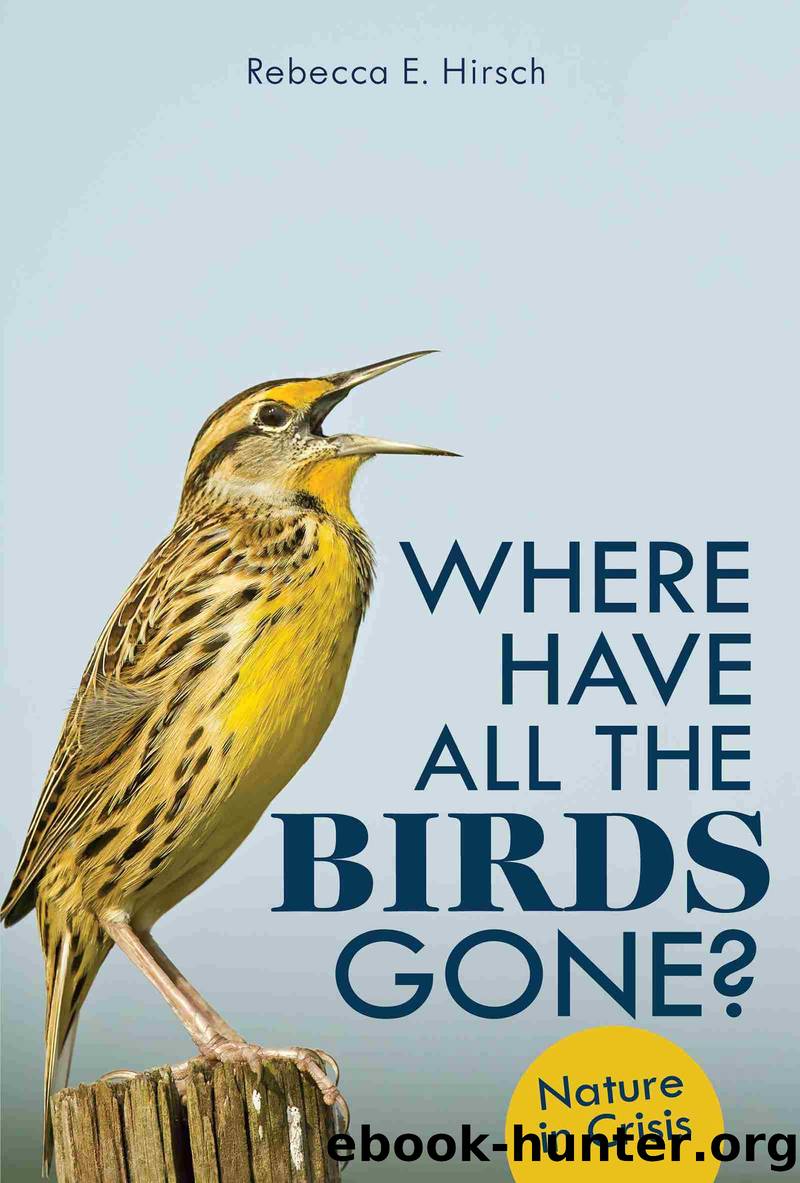Where Have All the Birds Gone? by Rebecca E. Hirsch

Author:Rebecca E. Hirsch [Hirsch, Rebecca E.]
Language: eng
Format: epub
Tags: birds, dying birds, bird-friendly glass, bird populations, migration, city lights, climate change, pollution, deforestation, ecosystems, food systems, mental health, ecology, ornithology, conservation, native plants, building habitat, backyards, sustainable farming, bird sanctuaries, FLAP, Lights Out program, domestic cats, birds of prey, songbirds, raptors, seabirds, nature, science, biology, environmental science, passenger pigeons, birdwatching, birders, bird feeders, flyway, bird count, pollinators, DDT, Silent Spring, windows, glass, pesticides, neonics, invasive species, monocropping, insect populations, agricultural intensification, agriculture, starvation, overhunting, mass extinction, Nonfiction, Young Adult Nonfiction, Young Adults
ISBN: 9781728455990
Publisher: Lerner Publishing Group
Published: 2022-03-02T00:00:00+00:00
The Late Bird
Researchers study white-crowned sparrows to see how neonicotinoids affect their health and behavior.
In spring 2017, Morriseyâs colleague Margaret Eng set up a mobile laboratory at Long Point Bird Observatory in Southern Ontario. The observatory sits on a narrow peninsula jutting out into Lake Erie and is home to a long-running bird-tracking program. The program traps migrating birds by snaring them in mist netsâfine-meshed nets that the birds canât see. Ornithologists and volunteers carefully untangle each trapped bird and wrap a lightweight metal band around its leg before releasing it to finish its migration. The band is stamped with a number and gives details on the species as well as the date and place of the birdâs capture. Bands allow observers to see which birds have been captured before and can help researchers keep track of birds as they migrate.
To help Eng with her project, bird banders at Long Point didnât release any white-crowned sparrows they caught in their mist nets. Instead, they handed the sparrows off to Eng. White-crowned sparrows have pale gray bodies and bold black-and-white stripes on their heads. They breed in brushy habitat in Canadian forests and stop in farmland during their spring migration, hopping on the ground in search of seeds. Eng wanted to learn what happens when birds such as these ingest small amounts of neonics.
Inside her mobile laboratory, Eng weighed each bird and then slipped it into a clear plastic tube. She inserted the tube into a dishwasher-sized quantitative magnetic resonance machine. The device scanned the sparrowâs body and measured the amount of water, lean mass (bone and muscle), and fat it contained. She then separated the sparrows into two groups. With one group, she used a syringe to feed each bird a tiny dose of neonics. A second group, the control group, received no pesticide.
Eng put the birds in cages. She gave them food and water, and they could eat and drink as much as they wanted. Six hours later, she again weighed each bird and scanned it in the quantitative magnetic resonance machine.
In that short span of time, she found that the pesticide-dosed birds lost on average of 6.5 percent of their body mass. Thatâs like a 130-pound (59 kg) teenager losing 8.5 pounds (3.9 kg) between lunch and dinner. Eng discovered that almost all the lost weight was from body fat, a birdâs main fuel for migrating. But the control birds didnât lose body mass or body fat.
Why had the birds lost weight after eating a bit of pesticide? By weighing the amount of food in the birdsâ cages, Eng discovered that the dosed birds had stopped eating. In people, nicotine suppresses appetite. Neonics were doing something similar to birds.
Eng wondered how this exposure would affect birds in the real world. After ensuring that each bird was âstill hopping around and happy,â she glued a tiny tracking device onto each birdâs back. The devices emitted radio pulses that could be picked up by a network of receiving stations.
Download
This site does not store any files on its server. We only index and link to content provided by other sites. Please contact the content providers to delete copyright contents if any and email us, we'll remove relevant links or contents immediately.
Harry Potter: A Journey Through a History of Magic by British Library(375)
The Science of Philip Pullman's His Dark Materials by Mary Gribbin(355)
The Basics of Organic Chemistry by Clowes Martin;(348)
Harry Potter and the Sorcerer's Stone: SparkNotes Literature Guide by SparkNotes(317)
Flowers in the Gutter by K. R. Gaddy(284)
Braiding Sweetgrass for Young Adults by Robin Wall Kimmerer(278)
Super Simple Chemistry by D.K. Publishing(274)
Summary of the Selfish Gene by Readtrepreneur Publishing(269)
Exam Success in Geography for IGCSE & O Level by Unknown(268)
JavaScript Coding for Teens: A Beginner's Guide to Developing Websites and Games by Yueh Andrew(264)
Dark days in Salem: the witchcraft trials by Deborah Kent(250)
The Python Audio Cookbook;Recipes for Audio Scripting with Python by Alexandros Drymonitis(249)
Analysis and Linear Algebra for Finance: Part II by Bookboon.com(244)
Key Immigration Laws by Kathryn Ohnaka(243)
Cracking the AP Economics Macro & Micro Exams, 2017 Edition by Princeton Review(232)
Solutions for a Cleaner, Greener Planet: Environmental Chemistry by Marc Zimmer(226)
The Science of Fashion by Julie Danneberg;(219)
Reverse Engineering For Everyone! by mytechnotalent(215)
Cracking the AP Psychology Exam, 2017 Edition by Princeton Review(208)
